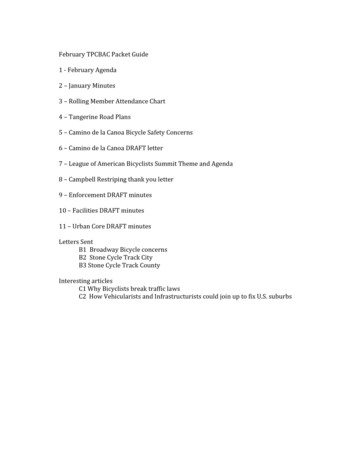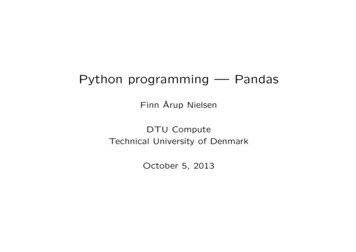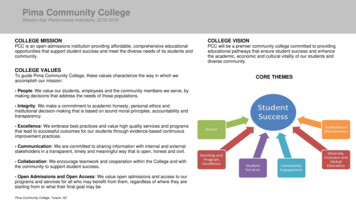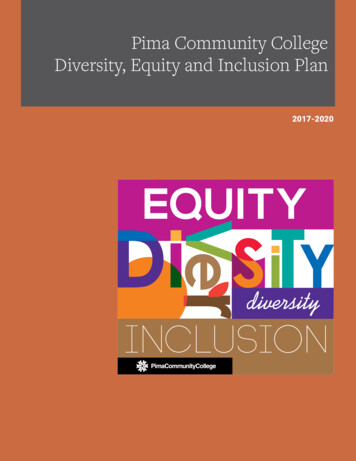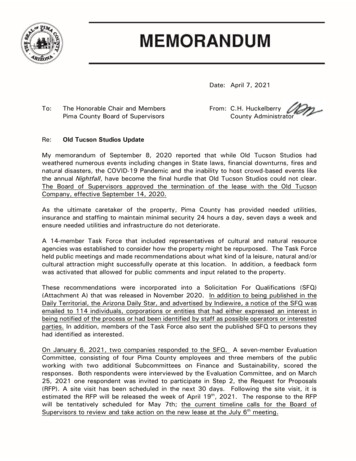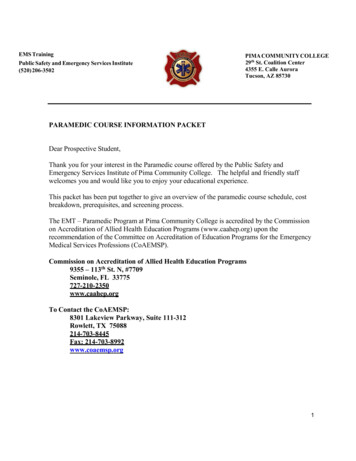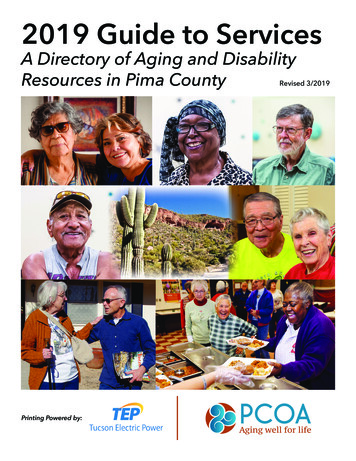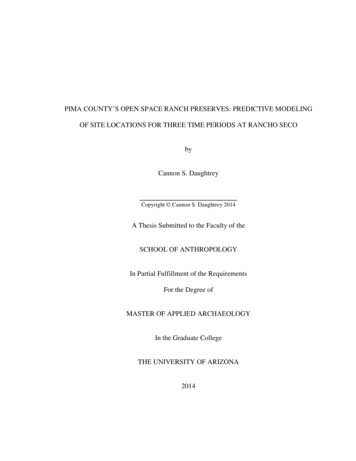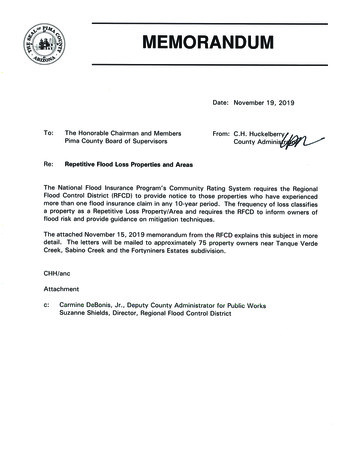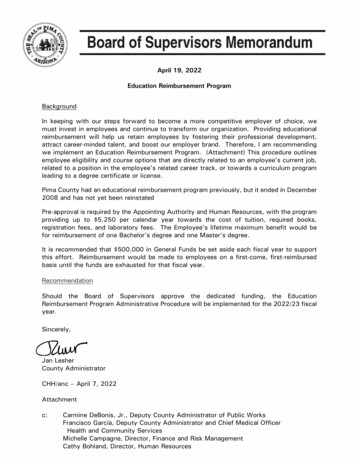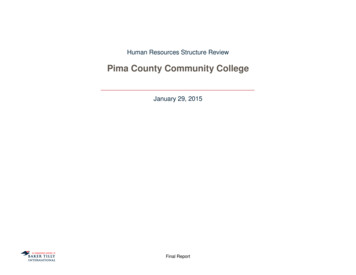
Transcription
Human Resources Structure ReviewPima County Community CollegeJanuary 29, 2015Final Report
Pima County Community College – Human Resources Structure ReviewFinal ReportTable of ContentsExecutive Summary . 1Project Scope and Methodology . 3Current State . 5Overall Findings . 5Key Areas of Concern . 6Human Capital. 6Human Resources Department. 8Human Resource Processes . 9Survey Results Summary. 11Future State Roadmap . 13Getting the Basics Right. 13Clearly Defined Human Resource Business Partner Roles and Relationships . 15Organizational Redesign . 16Overall Structure . 18HR Competencies . 26Future State Recommendations . 27Human Capital. 27Human Resources Department. 35Human Resource Processes . 40Integrated HR Processes . 44Appendix A – Interview List . 51Appendix B – Documents Reviewed . 52Appendix C – Survey Results and Analysis . 53Prepared by Baker Tilly Virchow Krause, LLP
Pima County Community College – Human Resources Structure ReviewFinal ReportExecutive SummaryPima Community College (PCC or the College) is a complex system of diverse public higher education institutions, consisting of six two-yearcollege campuses with unique focuses and cultures, three satellite adult learning centers, the Davis-Monthan Air Force Base Learning Center and1a facilities services division. For the 2013-2014 academic years PCC had 49,504 students enrolled in credit courses.Like many higher education institutions, the College has recognized the need to maintain its focus on providing a high-quality education to itsstudents. At the root of being able to provide a value-added educational experience is an effective, responsive and strategic human capitalmanagement function.Baker Tilly was engaged by PCC to review the current Human Resources (HR) structure, explore models and approaches to improve HRmanagement and identify a more effective, efficient and responsive HR department structure, which better meets the needs of the College. Therequest coincided with the review of the College by the Higher Learning Commission (HLC) resulting from the College being placed on probationby the accrediting body. Given the high level of scrutiny that PCC has recently received, it is a testament to College leadership that it has chosenthis opportune time to address optimization of the HR function college-wide.This assessment highlights recommended changes to ensure that the College is able to transition to a human resources environment where notonly the basic HR needs of faculty and employees are met, but also one where the HR Department can serve as a strategic partner for itsstakeholders. The review focuses on three main areas relative to human resources: Human Capital management College-wide The structure of and competencies in the HR Department Policies and processes related to human capital managementIn general, we found that the College is currently struggling to overcome a lack of trust in the HR Department and challenges relating to the overallapproach to human capital management. Additionally, a disjointed HR Department structure and insufficiently clear policies and processes relatedto HR has led to difficulties in delivering the basics of human resources functionality to employees of the College. Furthermore, a misalignment ofboth HR staff and College-wide staff and faculty competencies with the human capital needs of the College has led to HR staff job performancechallenges and low overall employee morale. With the implementation of our recommendations, the College could greatly improve itsmanagement of human capital assets and the delivery of human resource services, and begin to regain the trust and confidence of its customers.This report contains 19 primary findings and recommendations.1www.pcc.eduPrepared by Baker Tilly Virchow Krause, LLPPage 1
Pima County Community College – Human Resources Structure ReviewFinal ReportOur recommendations fall into the following broad categories: Collaborative leadership (HR and campus/program based) facilitating a high-level strategic vision and executable plan for human capitalmanagement at PCC Adoption of organizational structures and a culture that embraces a “shared” responsibility for consistently implemented human capitalmanagement Clearly defined roles relative to specific HR decision-making, authority and required transparency HR department focus and capabilities in alignment with campus and program/department needs Compliant and responsive HR processes and practices Establishment of College-wide training, including supervisor and job specific Comprehensive change management related to HR functionsRecognizing that there are still issues to be addressed, we did find several recent improvements related to human capital management at theCollege. These have been summarized below: Initial recognition of the strategic and collaborative partnership role to be played by the HR department Revision of the internal hiring policy resulting in the ability of all PCC employees to apply for posted positions Formation of the adjunct faculty and temporary employee task forces to provide a voice to generally underrepresented employee groups Highly functional and proactive Employee Service Center (i.e., Payroll and Benefits administration) Renewed focus on employee training and onboarding (e.g., hiring an experienced and proven Director of Organizational Effectivenessand Development)We would like to thank the College for their participation throughout this process and look forward to the opportunity to work with the College in thefuture. If you have any questions regarding this report, the discussions we facilitated, or future improvement approaches, please do not hesitate togive us a call.Sincerely,Christine Smith, PrincipalPrepared by Baker Tilly Virchow Krause, LLPPage 2
Pima County Community College – Human Resources Structure ReviewFinal ReportProject Scope and MethodologyBaker Tilly was tasked with reviewing the human resources function at the College which includes overall human capital management approachesCollege-wide, the HR Department and other HR related units, HR Department policies and procedures, and HR systems and frameworks. Thisreview was completed in order to make recommendations related to the following: Enhanced HR management effectiveness organization-wide Improved alignment of labor resources with strategic and program priorities Reduction to the level of effort required to manage the College’s workforce Reduction in risk from HR decisions and activities Improved implementation and enforcement of personnel policies and procedures Enhanced collaboration on critical HR activities across the CollegeIn order to achieve a comprehensive view of the HR function at the College, Baker Tilly employed several avenues for input, including: Survey of all PCC employees with over 1,000 responses received Over 28 focus group interviews with representation from (see Appendix A for a list of interviews conducted): PCCEA, ACES and AFSCMEFaculty Senate and Staff CouncilAdjunct Faculty and Temporary Employee Task ForcesVarious HR divisions and staff outside of HR providing human resource functions (e.g., Employee Service Center, FacultyCertification)College Executive LeadershipCollege Administrators Documentation review of PCC HR Department policies and procedures, including policies in the process of being rewritten (seeAppendix B for a list of documents reviewed) Review of HLC reports and PCC responsesPrepared by Baker Tilly Virchow Krause, LLPPage 3
Pima County Community College – Human Resources Structure ReviewFinal ReportBaker Tilly conducted 28 interviews in addition to hosting several open forums where employees were encouraged to engage with Baker Tillyproject members individually. Representation from various groups was encouraged and Baker Tilly was able to speak with representatives from allthree employee groups, Faculty Senate, Staff Council, staff members of various HR areas, multiple College administrators, College leadership andemployee task forces. Additionally, open forums were held at both the Desert Vista campus and the Downtown campus in addition to the DistrictOffice to encourage participation from employees on all campuses. The basis for the recommendations was validated with a variety ofstakeholders as part of the interview process.Many college employees took advantage of the opportunity to speak with the engagement team about human resources at the College. The openforums at the District Office, Desert Vista campus and the Downtown campus were well attended with the District Office and Desert Vista forumseach having approximately 25 participants. In addition to the open forums, open office hours were held where employees were encouraged tocome and speak one on one with the engagement team. Several employees took advantage of this option.Throughout the interview sessions Baker Tilly identified several themes that were repeated in multiple sessions by College employees from adiverse range of employee groups, campuses and functional areas. In conjunction with survey results and our review of documentation providedby the College, the themes elucidated during the focus groups comprise our findings and inform our recommendations.This report begins with the current state in which we present our findings, including key HLC findings, of areas in need of attention. The currentstate is followed by the future state section where we have detailed our recommendations for the College’s HR organizational structure, decisionmaking matrix and implementation of additional best practices.Prepared by Baker Tilly Virchow Krause, LLPPage 4
Pima County Community College – Human Resources Structure ReviewFinal ReportCurrent StateOverall FindingsThe engagement team has 19 findings in the areas of Human Capital Management, the Human Resources Department and Human ResourceProcesses. Below we define what we have included in these areas: Human Capital Management – Human capital management refers to the strategic approach to optimizing the College’s personnelassets. Many of the human capital findings involve human resource issues that require involvement from stakeholders throughout theCollege. These are opportunities that are not isolated to the HR Department but that affect the College as a whole. Human Resources Department – While all of the findings in this report relate in some way to the HR Department, the specific findingsin this category are those that can be implemented almost entirely within the HR Department. These recommendations focus morenarrowly on changes the HR Department can make without involving multiple stakeholders. Human Resources Processes – These findings relate to potential improvements to HR processes throughout the College. Findingswere only placed in this category if it was noted that the process was the root cause of the finding. If the main finding had a root causerelated to organizational structure, culture, strategy or change management, those findings were placed in one of the other categories.The following sections present our specific findings in the areas of Human Capital Management, the Human Resources Department and HumanResource Processes. The bullet points below summarize some of the high-level, key areas of concern that were presented throughout the courseof this study: The Human Resources Department does not function as a business partner to its stakeholders throughout the College There is no shared approach to human capital management between the campuses and the HR Department The College does not use data to drive strategic activities like workforce planning High turnover in key HR positions HR Department internal policies are unclear and applied inconsistently The HR Department operates on a tactical and transactional level, strategic direction and initiatives are missingOverall, we found that the College is struggling to provide comprehensive and effective human resource services to its “customers”, particularly inthe areas of talent acquisition, training, and employment processing. The inability of the HR Department to seamlessly deliver these basicfunctions has reduced the level of confidence of College employees in the HR Department. A recent Bersin & Associates study on high impact HRorganizations indicated that organizations that were unable to provide core services were also unlikely to obtain respect from leaders in the2organization.2Harris, Stacey. “The Top Best Practices for the High-Impact HR Organization”. January 2011. Bersin & Associates.Prepared by Baker Tilly Virchow Krause, LLPPage 5
Pima County Community College – Human Resources Structure ReviewFinal ReportMany of our findings focus on these core services while the remaining findings focus on more strategic HR activities such as succession planningand performance management. In the future state section of this report, we present our recommendations for each of these findings. Withthorough implementation of our recommendations relative to core services, the HR Department should be able to regain the trust and confidenceof its customers and begin to perform HR activities that will allow the department to serve as a strategic partner to its key human capital managersand other important stakeholders throughout the College.Key Areas of ConcernHuman CapitalThe following table summarizes our findings in the area of human capital.Item #CategoryCurrent StateHuman ResourcesLeadershipThe HR Department has had at least 5 changes in leadership over the past 12-18 months. The inconsistentleadership in HR has contributed to a lack of direction and focus on strategic HR management priorities andactivities. Additionally, this lack of leadership consistency is a contributing factor to the lack of consistency of HRprocesses.HR as a Business PartnerHR does not have a shared and understood approach to managing the College’s human capital. HR does noteffectively and consistently work in a collaborative manner with key human capital managers across campuses tocoordinate and develop solutions to human capital matters such as retirement planning, trending skill sets for faculty,and talent acquisition coordination. HR has been focused solely on tactical tasks, instead of an overall strategicapproach to human capital. Additionally, the current inconsistencies in applying HR policy and processes across thevarying units of the College has led to an inability to provide the level of responsive, efficient, and accurate HRservice and direction to its business partners that the College requires to effectively manage its human capital.3Professional DevelopmentAcross the College, training is insufficient to meet the needs of employee job preparation and professionaldevelopment, nor are training programs in place to ensure compliance with key HR related activities. For example, asit relates to hiring practices, members of hiring committees and hiring managers are not adequately trained oninterviewing techniques and who to contact with questions or concerns related to specific HR functions such as EEO.Overall, employees of the College are not trained adequately on systems and processes related to their job. Inaddition, training for first line supervisors is not mandatory which creates considerable risk for the College.4OrganizationalDevelopment (OED)OED is underutilized by both the Human Resources Department and the College as a whole. As indicated previously,the College lacks a systematic approach to both general and job specific training. OED staff is willing and available toassist in a more significant way to train and/or collaborate on training College employees and ensuring that humancapital resources develop key competencies in emerging or priority job requirements.12Prepared by Baker Tilly Virchow Krause, LLPPage 6
Pima County Community College – Human Resources Structure ReviewFinal ReportItem #CategoryCurrent State5Change Management – HRTransformationEmployees do not have trust or confidence in the human resources functions at the College. Although multiple effortsare currently in progress to improve human resources delivery at the College, these efforts and recent HRtransformation successes have not been thoroughly communicated to employees. Therefore, employees continue todistrust Human Resources and are not engaged in human resource management improvement.6Required CompetenciesThe recruitment and selection process does not allow the College to obtain the most qualified candidates with theappropriate competencies for the position given that it is currently much more of an intake process. The HRDepartment does not take a proactive approach to recruiting qualified, experienced, and diverse candidates. Forexample, the HR Department does not participate in conferences to help build recruiting networks and seek outcandidates, or use social media or subject expertise specific forums to promote and advertise vacancies.Additionally, the posting of open positions is limited to a small window of time (7 to 10 calendar days) and posted invery few places, if at all, outside of the College’s internal job site (i.e., Pima jobs). This may limit the pool of qualifiedcandidates that results from the search. Also, a lack of understanding by recruitment staff of the skill set needed forspecialty or niche positions does not allow them to recognize transferrable skills in potential candidates. Hiringmanagers expressed that qualified candidates are often removed from the pool due to this lack of understanding.7Succession PlanningThere is no formal succession planning at the College. Employees throughout the College expressed that there is nota clear path to achieving career goals and continuing to grow within the institution. The College does not identify anddevelop leaders throughout the College to step into new roles when they become available.Compensation ProgramAlignment withPerformance ManagementThe College's annual performance review process, which is crucial to managing employees’ development andleadership skills and aligning PCC’s human capital strategy College-wide, is widely viewed as arbitrary. The Collegecurrently has a Step Progression program that requires specific steps to be completed, which are not necessarily tiedto job performance, to receive an increase in pay. The Step Progression program is not tied to the annualperformance review process; thus, there is little incentive for employees or supervisors to complete annualperformance reviews because there is not a merit based salary incentive. In general, employees from variousemployee groups and at various levels in the organization indicated that they would like to have a performancemeasurement system that identifies areas of growth and recognizes their job performance achievements.Employee RelationsUnderperforming employees are a systemic issue at the College. It was widely reported that underperforming anddisruptive employees were difficult to terminate and discipline. This poses a risk to the College, decreases overallefficiency and reduces employee morale. It should be noted that the Human Resources Department has a newEmployee Relations Director and that some changes have been made over the past year to the employeedisciplinary process. It is unclear whether all of the issues presented in the interviews stem from past employeerelations practices or if there are still ongoing issues with the system. However, it remains that many supervisors feelthat they are unable to remove ineffective employees and that the employee disciplinary system is broken.Decision Making AuthorityIn multiple functional areas of the College (including human capital management) it is unclear who has the finalauthority to make decisions. Additionally, middle managers are not empowered to make business decisions andupper level management is relied upon to make an unusually large number of operating decisions. For example,campus presidents approve every hire at each campus. In most cases, the hiring manager, along with his/hersupervisor should be capable of making this decision. Additionally, most employees feel like they have to go all theway to the "top" in order to receive approval or a final decision for most operating procedures.8910Prepared by Baker Tilly Virchow Krause, LLPPage 7
Pima County Community College – Human Resources Structure ReviewFinal ReportItem #11CategoryData AnalyticsCurrent StateThe College does not widely use data analytics to make operating decisions related to human capital and generalbusiness decisions.Human capital management leadership is crucial to ensuring items 1 – 11 above are fully implemented and vetted to meet the needs of PCC. TheHR Department may take the lead, but human capital management is not the sole responsibility of the HR Department. For human capitalmanagement to work effectively, College-wide collaboration is required to ensure the College’s human capital needs are being met, but alsostrategic planning is occurring related to matters such as succession planning, industry leading practices, talent acquisition trends in variousacademic and functional areas. Human capital management leadership requires top leaders (e.g., Chancellor, Vice-Chancellors, Deans) toemphasize its importance, while also obtaining buy-in and feedback from stakeholders on all levels College-wide. Human capital managementshould be a standing agenda item during the Chancellor’s Cabinet meeting, including frequent follow-up to ensure progress at the CampusPresident/Vice Chancellor levels.Human Resources DepartmentA specific focus of this project was also related to the effectiveness of the actual Human Resource Department. The following table summarizesour findings for the Human Resources Department.Item #12CategoryClassification andCompensationCurrent StateThe College's classification specifications are not regularly reviewed which can lead to outdated jobcompetencies and related compensation. This is especially true for functional areas that experience rapid changesuch as Information Technology. Additionally, the College has not conducted a market analysis in approximately15 years. Without being aware of market salaries and classification specifications, the College cannot beconfident it will recruit and retain the best potential candidates.Furthermore, new hires must be hired by the College at the first step of each grade of their classificationregardless of their years of experience. This may limit the pool of qualified candidates that apply for positions withthe College and does not incentivize highly experienced candidates to apply to the College.13HR Department Policy andProcessClarity/Knowledge/FrameworkThroughout all human resources functions there is a lack of clarity surrounding HR Department processes andpolicies. Process and policy interpretation appears to differ by employee group and which HR employee isperforming the interpretation. This has resulted in inconsistent application of policies and procedures, poorcustomer service and lack of responsiveness, which has negatively affected the reputation of the HumanResources Department within the College and also the reputation of the College as a whole, as noted by therecent HLC matter.Additionally, there is a lack of framework related to HR Department process and policy interpretation and clarity(e.g., How is a policy created? How is a policy implemented? How is a policy monitored to verify it is workingeffectively?) For example, when processes and policies are changed and/or updated, interviewees indicated theywere not informed and could not locate the documentation noting the changes/updates.Prepared by Baker Tilly Virchow Krause, LLPPage 8
Pima County Community College – Human Resources Structure ReviewFinal ReportItem #14CategoryCurrent StateParticularly with administrative staff, the College does not perform workload analysis. Therefore, somedepartments could be overstaffed while others appear to be understaffed. Understaffed departments can be justas inefficient as overstaffed departments causing poor quality of work, bottlenecks and high employee turnover.Workforce PlanningHuman resource functions across the College lack collaboration. The siloed divisions within the HumanResources Department have led to a lack of collaboration within HR, which has resulted in miscommunicationsbetween staff, poor customer service, and missed opportunities to enhance HR services.1516Organizational StructureAdditionally, there are critical HR functions that report through Finance (i.e., Payroll and Benefits) and theProvost's Office (i.e., Faculty Certification), but have limited interaction with the HR department. The lack ofcoordinated effort between HR, Finance, and the Provost's Office has created additional impediments towardcollaboration and negatively impacted customer service and effectiveness.Collaborating and LeveragingEffort and EconomiesHR functions do not collaborate and leverage effort and economies to provide a more effective means of meetingstakeholder needs by working together on “like” initiatives. For example, if the College has five campus hires for asimilar position, HR would currently post each position separately and each campus would compete against theother, instead of coordinating efforts and obtaining a large pool of qualified candidates to meet each campus’needs.Human Resource ProcessesKey to effectively implementing consistent and compliant human resource activities is the presence of clear processes and procedures andconsistently following processes and procedures. The following table summarizes our findings relative to Human Resources processes.Item #17CategoryMeet andConfer/EmployeeGroupsCurrent StateThe College's three employee groups (ACES, PCCEA and AFSCME) ar
Pima County Community College - Human Resources Structure Review Final Report Prepared by Baker Tilly Virchow Krause, LLP Page 2 Our recommendations fall into the following broad categories: Collaborative leadership (HR and campus/program based) facilitating a high-level strategic vision and executable plan for human capital
